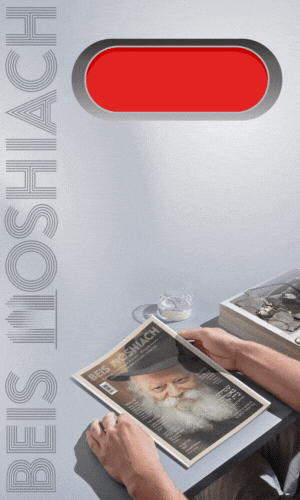The Power of a Combination Lock
We all know what it takes to keep a space going. There are heat bills, cleaning costs and other very basic maintenance needs that add up over the course of the year. In the craft of fundraising, there are many tools. However, the cheapest of all fundraising schemes costs under $100 and lets you fundraise while you do other things • By Raanan Isseroff, Beis Moshiach Magazine • Full Article
Raanan Isseroff, Beis Moshiach
In the craft of Fundraising, there Are many tools. The database, fundraising letters, yearly mass & brokered mailings, used car donations, dollar-by-dollar/door-to-door collectors, telemarketing, appeals, raffles, breakfasts (luncheons and gala dinners), website, theme, catchy logo, honorary board, PTA and more. Please G-d, we will get around to discussing how to implement each one.
However, the cheapest of all fundraising schemes (if you have a space), costs under $100 and lets you fundraise while you do other things. I’m talking about a combination lock for the front door of your shul/Chabad House.
We all know what it takes to keep a space going. There are heat bills, air-conditioning bills, electric bills, coffee, milk and sugar expenses. Light bulbs, paint, varnish for the floor, cleaning costs and other very basic maintenance that over the course of a year adds up.
Consider this:
- You have a space. It costs money.
- You want people coming in.
- You want to find a way to cover your costs for the area.
- You want to do shlichus.
But you just can’t be there all the time. On the other hand, you don’t want just anyone walking in. Get a push button combination lock.
A Tale of Three Shuls
Consider these stories of Chabad of Anytown, Beis Chabad of Somewhere, and Congregation Beis Ploni. These are true stories of real places, names changed to protect the innocent.
Chabad of Anytown started as a community effort with all the local Chabadniks working together. Chabad of Anytown sits in the beauty of the mountains on the frontier area of eastern Eretz Yisrael. In contrast to the surrounding breath-taking scenery, Chabad of Anytown ranks as one of the poorest and dumpiest shuls in town. Surrounding Chabad of Anytown are wealthy Sefardic, Litvish and Chassidish shuls. Each with fancy wood and plush cushioned seats.
Chabad of Anytown is two caravans. The windows have bars. Nothing is too plush inside.
Originally, the shul had an open-door policy. However, the shul president decided that “wild people come in at night” and so he ordered the shul to be kept locked. Therefore, it’s only open when there’s a minyan. When shluchim there get someone interested in being religious, it’s a bit tough for the newcomers as they have to go learn, daven and farbreng at one of the other shuls that are (always) open.
One Shabbos, I was in this town for Shabbos mevorchim. Looking to say Tehillim before davening, I asked one of the locals where is Chabad located? He gave a laugh and said: “It’s a waste of time to go there, it’s not open before 8:30.” I was really embarrassed.
Being a bit stubborn, I anyways went. Arriving at the shul, I found it closed.
I had a hard time understanding why. After all, all the richer shuls doors were wide open. Finding a fancy Sefardic shul totally open and empty, with coffee and hot water, I had my coffee and began Tehillim.
I was amazed. It was 6am and in this frontier community, all the much wealthier shuls were open. Gosh, theirs have fancy wood and even leather seats. Gilded arons and beautiful seforim. To my inquiry as to why the Chabad shul was different, the Rabbi told me that people worried the Torah would be stolen or tampered with.
I later had a discussion with the Rabbi and my host and found that once the shul used to be left open 24/7. Then, the community was livelier. People used the area to meet and plan. Farbrengens just “happened”. Today however, things are different. Shul management had changed, and they decided that “who knows who might walk in”. As such, the shul is only open when the gabbai or Rabbi is there (to the Rabbi’s credit, this was not his decision). My host was upset too, but there was nothing he could do. “We have a certain balance of shalom here and I don’t want to create machlokes”, he told me.
Furthermore, he told me that they were trying to build a normal shul, but raising money was hard. People aren’t rich, etc. etc. That was a year ago. Today, nothing has changed. In fact, people are considering breaking off and forming another shul. The shul continues to be as poor as ever.
Beis Chabad of Somewhere
Congregation Beis Chabad of Somewhere was started by a very enthusiastic Chabad Rabbi in a not-so-poor, very Litvish area that really could use another Chabad Shul in its growing community. The Rabbi is a dynamic one-man-show who people love. Each holiday, he’s out there banging away on doors, raising money and making holiday and Shabbos events happen. He has a tough time, but in the end, he comes through and the event happens. However, if he doesn’t fundraise? — Nothing happens.
What about during the week? The shul has a long history of ups and downs. Why? Because Mr. Dynamic Rabbi simply will not open the shul door unless he himself is there.
I asked him once about this odd phenomenon and was told: “People can’t just come in and do what they want.”
Did I mention that our super shaliach is not exactly an “always on-time” guy?
In fact, sometimes he forgets to come or has something else to do. Well you know, people just get tired of waiting outside of a locked door. As you can guess, the Beis Chabad of Somewhere minyan has had its ups and downs.
The Rabbi is upset that he keeps losing spaces. He can’t understand why. They’ve moved at least six times. Each new location brings new hope. However, the same sad scenario plays itself out each time.
In the beginning, the Rabbi is always there. Then he misses one day or another. Or he goes overseas and the minyan is over. It’s a project to find more interested people. But to the Rabbi’s credit, he does it over and over again.
The Story of Cong. Beis Ploni
Congregation Beis Ploni opened as a kid’s program in a community of many minyanim. The Rabbi didn’t see any need for a normal minyan, as the area is used for kids from religious families who need a hang-out place that isn’t a bar. From its conception, the area had a push-button lock. The Rabbi is old-school. A young man, but he believes the area should be available for his “congregation”.
In case you haven’t guessed, a minyan is the last thing on their minds.
The kids come in and make a tremendous mess. But that’s what the areas for. As such, kids wander in and hang out 24/7. With them, come all sorts of people. One night, they broke in, breaking the lock and just hung out. The Rabbi was upset, but I pointed out: “Look! This is a sign of success! They are even breaking down the doors to get in! How many Chabad houses wouldn’t be envious of you?”
I told her I would find out. A call to the Rabbi confirmed that, indeed, her son was a nightly “hanger” at Beis Ploni. Yes, it has happened a few times that certain people were deemed “not-welcome,” a rare occurrence at Congregation Beis Ploni. In these cases, the Rabbi simply changed the combination, advertising the new password to everyone, and that was it. Problem solved.
Where I am in Tel Aviv, there are two other Chabad shuls that exactly mirror the above problem. The Rabbi of one was appalled at the idea of leaving the door open (“who knows who might make themselves at home?”) while the director of the second one thought it was a good idea.
The Beis Ploni Morning Minyan
Now, our Rabbi of Cong. Beis Ploni is not-exactly what one would call “an early riser.” Not a lazy person at all, mind-you, but a morning person? No.
Some of his “congregants” advanced and thank G-d, married. Not quite run-of-the-mill standard Chabad, still, they wanted to make a minyan. One group, very serious people, had a minyan going someplace else. A new group started a morning minyan in Cong. Beis Ploni. This new minyan wasn’t so advanced. Their minyan was of the “Hodu ve’ad kush” variety [i.e., that kissing the siddur at the end of davening happens in close proximity to saying Hodu at its start…], breaking all world speed records. The usual speed was clocked as being 15 minutes between Hodu and Aleinu and that was considered “slow” …
Rabbi wasn’t up so early for the first years. As such, without the Rabbi, the minyan davened quickly and left. Interestingly enough, we started losing them one by one. They were replaced by another group a bit more serious.
On a side note: One morning I was very early at another neighborhood shul and saw a crowd of people at 6am sitting quietly around one of the community mashpi’im who was giving a shiur in Chassidus. Curious, I sat for a bit on the side. Looking around I was amazed. One after the other, I identified our missing “Hodu Ve’ad Kush” minyan…
Kids eat you know. I’m sure you all are familiar with this situation.
Whatever you think a Chabad House feeds people Shabbos is nothing compared to what hungry teens consume weekly. It was a constant challenge to find donors of kosher food. Not to mention the cost of coffee, milk and cookies.
Our minyan wasn’t too blessed with learning or davening abilities, however, in their rush to get to work, it bothered people that there wasn’t enough coffee. One person who worked in Manhattan would stop in at Trader Joe’s and have coffee ground. Of course, coffee isn’t drinkable without sugar and milk. Someone else brought milk. The crummy styrofoam cups too are not the same as larger waxed paper cups. Someone else started bringing the more expensive paper hot cups.
Another person upset at the ancient coffee pot and bought a drip coffee maker. Someone later donated an Italian espresso machine.
As the minyan got more established, a more serious crowd from the neighborhood started coming. How many minyanim have leather couches to sit on? The word got around about the good coffee and leather couches and pretty soon a more advanced crowd began to frequent the place. The Rabbi’s schedule changed making him a morning person, so now he gives a shiur before the minyan.
One person upset at the paint job, paid for painting the area. Another paid for a new floor. Another paid for tables and chairs. Finally, someone paid for a decorator and today, the place is a palace! The area is popular for small events, bas-mitzvahs, birthdays and brissim.
In short, the place is paying for itself.
Compare this to Chabad of Anytown on the frontier of Israel or Beis Chabad of Somewhere, which only let select people in, and only when the Rabbi’s there.
How did it all start? With a $75 Combination Push-Button Lock.
This wealth could be yours too. Not bad for seventy-five dollars.
One Shliach told me: “But then the homeless will come in.” I put my arm around his shoulder (bless his soul) and said with a smile: “G-d forbid, someone homeless might come in, have a cup of coffee and learn Torah!”
He smiled. “Ahh! The penimiyus of the inyan…”
Where I am now, here in the Holy Land, one sees a clear difference in success of shuls. Here, money is tight and shuls that are open, or have open door policies are very successful, while those who are nebach not, have terrible financial problems. After banging my head against the wall explaining this radical idea to skeptic shluchim and Rabbis, I decided to write up the whole idea.
Again, all it costs is $75!
***
Fundraising Lesson 2: Hello! Make a minyan.
As we already began this topic, I’d like to add some more thoughts on the relationship between Chabad Houses and minyanim:
Often, I’ll hear a Shliach saying things like this when asked why he dosen’t have a minyan happening in his place:
- ”I need my space for programming and activities, but not for a minyan.”
- ”There are other minyanim in town.”
- ”I make a minyan, but we daven the same time as the Rebbe’s minyan.
- ”I don’t want to compete with the other minyanim in town.”
- ”I don’t want people there when I’m not there.”
- ”I would do it, but I can’t be there to supervise.”
Look at the example above. The Rabbi wasn’t even interested in making a minyan as part of his shlichus. However, the minyan became the focus of his fundraising and today, he is there (mostly on time!) for the minyan and does a live online shiur after the minyan.
Shlichus is about Adapting to the place’s custom
Each place has its own time when people normally daven. The trick is to match their time with your schedule. Here in Tel Aviv, that time is from 6 – 7am.
Another example:
Here in Tel Aviv there is a new minyan. However, nebach, each time I go, even for the advertised 9am minyan, the door is locked. To top it off, the Rabbi refuses to start without 10 people…
So, the 9am minyan usually starts about 9:30 or 10am. But only if the Rabbi lets it start. As such, the minyan has been losing people. Which is really a shame, as he has a young wealthy crowd. (Hopefully, he’s reading this. I really wrote all this for him)
In that neighborhood of Tel Aviv, people just don’t pray at 9am. Everyone’s at work by then.
To the Rabbi’s credit — and he is truly a wonderful person — he is mostly on time and usually, most days, there is a minyan. But every day there’s this awful tension and few people actually enjoy the davening. What they do enjoy is the relief of getting out on time.
The other two Chabad minyanim I frequent in Tel Aviv have the same problem. Each opens late and only when someone is there. Each has problems making a minyan.
Isn’t it really supposed to be the other way around?
A shiur in the morning, some hisorerus (excitement) before davening. Then, davening with fervor and excitement? A push-button lock solves all that.
People come and go when they please. And your shlichus begins to pay for itself.
***
Another answer I get is that, “My place is not set up for visitors when I’m not there.
Good point.
This point is very key. Doesn’t it say “Hachacham einav b’rosho?”
A wise person’s eyes are in his head. In other words, think into how the area needs to be set up, to have this all happen.
When you have kids, what does one do?
We move everything breakable to upper shelves. Lower shelves are locked or child-proofed. Children’s gates are put on doorways and stairways.
The same is true here.
You have to set up the area intelligently to accommodate visitors.
You want a coffee area for guests, but you don’t want them near your meat area or the food. To do that, a separate milchig coffee area has to be set up outside of the kitchen. A small fridge (beer fridge) needs to be placed outside the kitchen to store milk. The kitchen door needs to be locked. For if not, people will dump their hot coffee with the milk into your meat sinks. They will splash hot milk on your meat counters.
Your office must have a door and be locked. The computer has to be in the office with a password. Anything valuable has to be locked away. The Aron is usually locked anyways, but if it’s not, lock it up better with a fireproof safe. Anything you don’t want people touching or taking, must be locked up. Look at this as an educational tool as well. People coming in are looking to learn how to live like a Jew. They take note of every detail! “Look how the Rabbi dresses” or “See how the Rabbi keeps kosher in shul.” Just like by the Pesach Seder, we davka want the children to take note of how this night is not like all other nights. So too, we want people to learn about the mitzva of kashrus. They will notice we have a major separation between milk and meat. They will also learn about the great mitzva of Hachnosas Orchim. You can post the brachos in English over the sink too for each kind of food they will eat.
Additional Ways to Have Extra People Around When You Are Not
You can always offer to local kollel guys to come learn, which ensures that people are on the premises when you aren’t. You can set up a shlichus program that requires students to be in the area from 6am and during the day at different times. Start a shlichus program with a stipulation that the boys will be there learning from very early in the morning.
I believe you will find out that your fears are unfounded, as the proof of centuries of shuls and batei medrash around the world who left their doors open for anyone to come learn at all hours of the day and night.
On the Deeper Side
On another note, if we look into shlichus a little bit, (between bouts of the sickness of fundraising), what are we really trying to do here?
We are setting up the nucleus of a future Jewish community that will be, please G-d, based on chessed. Just like Avraham Avinu had a tent with four doors, a Chabad house in the desert established on the foundation of chessed. We are training visitors what chessed means. If one thinks into the visitors to Avraham Avinu’s tent, if he had stopped to consider “is this one normal” each time, would I even be around to write this article? Would you be here to read it?
We are training Jews totally unused to a shtetl style of life, to give, give, and give!
Something foreign to American, Canadian and Israeli non-religious Jews.
Doesn’t every town and city have to have a place for wayfarers or the needy to sleep? A Hachnosas Orchim? What about a free soup kitchen? What town in Europe or Morocco didn’t have these things? And what about gemachs of all sorts. An interest free loan fund. A clothing gemach, furniture gemach or medical equipment gemach.
A free cup of coffee? In Israel or the United States it’s unheard of.
“Heaven forfend! Who might such things attract?” This whole foreign non-Jewish selfish thought process is what we want to turn around. For that matter, why should one want to give to your Chabad center? To train a donor, you have to give a prize. Okay. In yeshiva isn’t one trained that we can do mitzvos without a prize? But that’s for the mature older teen. That is for yeshiva kids. When we were kids, didn’t the teachers give out prizes for davening, sitting and learning? Our mekuravim are not on such a level. As such, we have to give them a “prize” for doing mitzvos.
Here too. Someone coming to Chabad for the first time has no concept of things for free. No concept of chessed. Your Bais Chabad is his/her first taste of what Jewish life, a life of chessed, really means and that takes training.
Training to feel for another Jew’s pain. To develop a perception that another person needs. This all comes with training. The Baal Shem Tov describes this situation. “A Jew should give a krechtz (groan) for another Jew’s pain and rejoice in another Jew’s simchas.”
When we take the time to train our visitors in giving, then of course, they will also want to give to you too! And if someone should come in when you aren’t there, and while noshing your coffee and cookies, picks up a sefer and learn Torah or sits by a shiur? Mah naim goraleinu!
The best part of the above, is that it frees up your time, allowing you to do shlichus and you don’t have to be there.
The moral of the story: Change your lock and start raking in the bucks!
*
The magazine can be obtained in stores around Crown Heights. To purchase a subscription, please go to: bmoshiach.org
154
Join ChabadInfo's News Roundup and alerts for the HOTTEST Chabad news and updates!










































